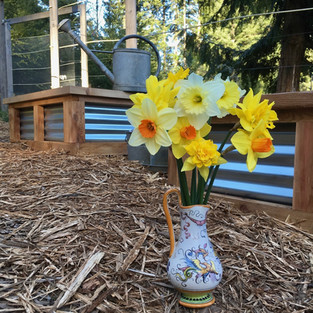Grow your Own!
- stacy
- Mar 26, 2020
- 4 min read
Updated: Dec 26, 2022

Now more than ever I am grateful for the space to grow a large garden and for the skills to preserve our harvest to provide greater food security than was practical when we lived in the city. We've got quite a few home canned goods still in the pantry and the freezer that I put away last year - marinara sauce, roasted tomatoes, pesto, roasted chilis, kale and chard, Hubbard squash, applesauce, pickles, jams and jellies. Plus we've got frozen fish and crab from my husband's last fishing trip, honey from our bees, and plenty of eggs from our flock of chickens. I also left some kale and leeks to overwinter in the garden last year, and I've been harvesting and adding those to meals as well. Despite a late snowstorm on March 15th, it's finally spring here on the farm and gardening season is underway.
I started the first of the cool season vegetable seeds in the greenhouse in mid-February, and we've got starts of kale, Swiss chard, lettuce, peas, onions and leeks getting close to being ready to transplant out in the garden. There's still time to get your cool season veggies started, and if you are new to gardening, or only have a small space to garden, these are all very easy to grow and will give you a harvest in a relatively short amount of time. It just wouldn't be summer without the bounty of exciting fruits and warm season vegetables that I also like to grow. So now is also the time for planting strawberries, blueberries, and raspberries, and if you already have these in your garden it's time to clean up the beds by cutting back dead branches or canes, thinning plants as necessary, and adding a fresh layer of mulch to conserve moisture and prevent weeds. I've just cleaned up my fruit beds last week, and the raspberries and blueberries have already started budding and leafing out. I've also started my tomatoes in the greenhouse, although since I don't use any supplemental heat in my greenhouse, the tomatoes are just starting to sprout. That's okay because our average last frost date here isn't for another month, and I don't transplant my tomatoes outdoors until night-time temperatures are reliably in the mid- to upper-50's. I'll be starting the rest of my warm season veggies including cucumbers, peppers, corn, beans, squash, and pumpkins in the next few weeks.
I've got several new planter boxes that I'll be using to grow flowers this year. One of my goals for 2020 is to grow more flowers so that I always have plenty for fresh cut bouquets. While I do get excited by having fresh vegetables in the garden, flowers are what really make me happy and we all need to do what makes us happy sometimes. My husband built me several planter boxes using corrugated metal and rough-cut cedar, and the boxes line the border of one side of the vegetable garden. They are inside the electric fence that surrounds the vegetable garden to make sure that the deer don't get to the flowers before I do! I've started several types of flowers from seeds in the greenhouse, including some really fun varieties. In addition to the calendula, marigold, coneflower, bee balm, lavender, and sunflowers that I always grow, I'm also planning to grow chocolate flower, Mexican hat, bee's friend flower, strawberry fields Gomphrena, China aster "Moonstone", and several varieties of zinnia this year.
Another fun thing I'm going to try growing this year, despite failing miserably at it last year ;) is luffa. Because as much as I try to be practical and grow mainly things that I know will do well in our climate, I can't resist a challenge every now and again! I'm also going to try to grow some decent sized pumpkins this year. I have a new hugelkultur bed that I'm hoping will be the secret to success with growing pumpkins. I've heard great things about this technique so last fall we built a small hugelkulture bed, about 6 feet in diameter right outside the veggie garden, and we've also got a second, larger but more rustic hugelkultur bed where we've been piling cut branches and other yard debris for a few years. I'm excited to give both of these a try. For those of you that aren't familiar with hugelkultur, it is an ancient agricultural practice of making raised mounds by piling up logs and other organic, compostable material which over time produces a nutrient dense growing environment that requires low maintenance and no irrigation or fertilization. I have three varieties of pumpkins that I'll be trying to grow this year. I ordered seeds for "Full Moon" pumpkin and "Galeux D'Eysines" which is a really cool warty pumpkin. I also saved some seeds from the Cinderella pumpkin I bought at a local farm stand last fall, and hopefully if all goes well, we'll have a nice little pumpkin patch of our own this year!




























Comments